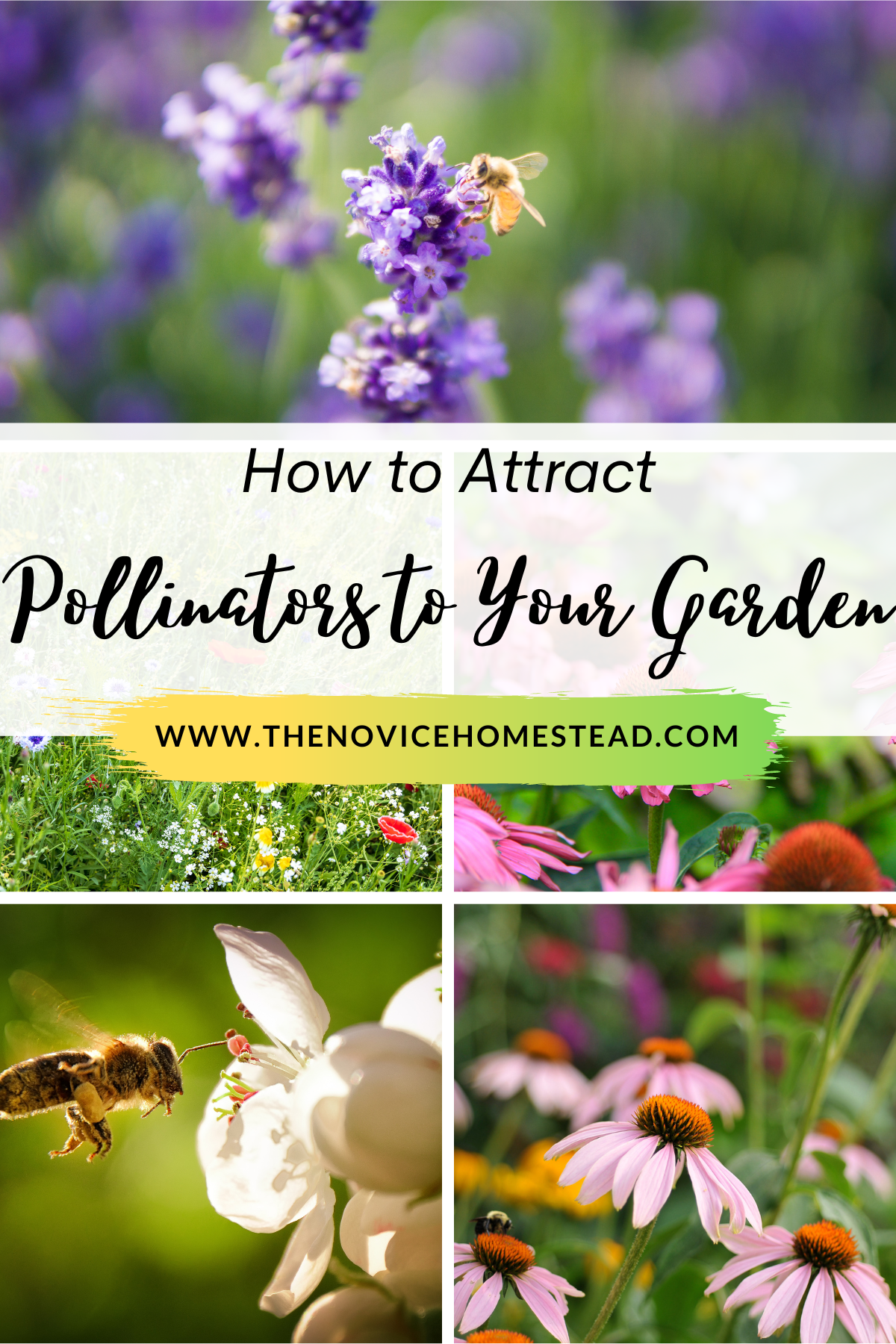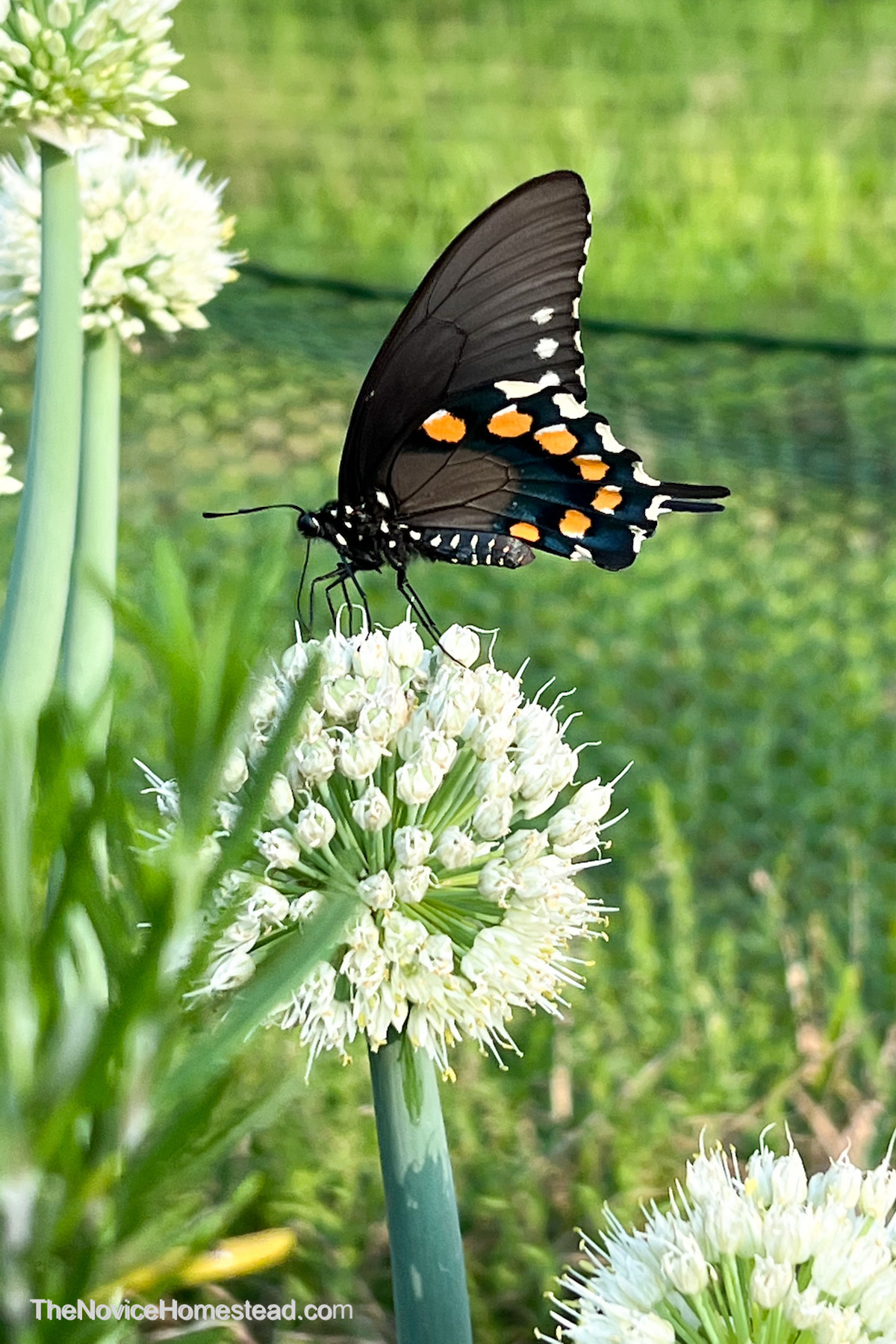Pollinators are essential for your garden to be a healthy and productive ecosystem! Learn how to attract pollinators to your garden with these simple tips.

What is a Pollinator?
Pollinators are animals that help transfer pollen from the male part of a flower (stamen) to the female part (stigma), allowing plants to reproduce, creating fruit and seeds.
Some of the most common types of pollinators are:
- Bees – Perhaps the most well-known of the pollinators are bees, of which there are more than 20,000 species. Bees are very effective pollinators, collecting pollen to feed their young, and going from plant to plant as they do so.
- Butterflies – Butterflies use their long, slender tongues to sip nectar from flowers, transferring pollen at the same time.
- Moths – While you may see moths in the garden during daylight hours, they are most active at night, visiting flowers that are open all they time or that open at night.
- Hummingbirds – Birds that eat plant nectar, such as hummingbirds, transfer pollen as they fly from plant to plant.
- Wasps – While they are often viewed as pests, many wasps are actually helpful pollinators. However, there are a few types of wasps that are not known to pollinate, such as hornets, yellowjackets, paper wasps, mud daubers, cicada killers, and tarantula hawks. I generally leave wasps alone, but I do get rid of aggressive wasps in our yard that can be dangerous to kids or pets.
- Bats – Though they primarily consume insects, there are some types of bats that eat pollen and nectar from plants, pollinating as they do so.
- Beetles – Beetles are not prolific pollinators, but some do have hairy bodies that pick up pollen and transfer it from plant to plant.
Pollinators are absolutely essential for the ecosystem! Without pollinators, plants would not produce the foods that we need to eat. You NEED pollinators in your garden!
Related: 8 Bugs That Are Good For Your Garden
5 Easy Ways To Attract Pollinators
The following are simple ways to make sure that pollinators visit your garden. Having plenty of pollinators will help ensure that your garden is productive.
1. Plant a Variety of Flowers
The easiest way to attract pollinators to any garden is to plant many kinds of flowers. Different species of pollinators are attracted to different types of flowers, so variety is key.
Plants in your vegetable garden will usually have flowers, and sometimes that is enough to bring the pollinators into your garden. However, I always plant a few extra types decorative flowers that are fragrant, have bright colors, are taller than my other plants (think: sunflowers) – anything that might stand out to a pollinator on their journey so they stop by my garden.
Another one of my tricks for attracting pollinators is to allow some of my plants to “bolt” and start to flower and go to seed early. Summers in Texas can be quite hot, so I can’t always prevent certain plants from bolting if we get an early heat wave. Instead of pruning, I allow some of these flowers to stay because they are favorites of many pollinators.
For example, my green onion plants always flower in the spring and summer, but I leave those blooms in place because they attract SO many bees and butterflies, like this Swallowtail Butterfly below:

I also let my Thai basil bolt because those beautiful purple blooms are another pollinator favorite! I still get plenty of basil leaves AND I get lots of helpful insects!
2. Provide a Water Source
Pollinators need water to survive, so providing a water source in your garden can be a great way to get a wide range of pollinators to swing by.
A bird bath is a versatile water source for many flying animals. However, you don’t even have to get that fancy with it. You can simply place a shallow dish of water in your garden area. Placing marbles or small rocks in the bottom of the dish can make it safe for bees and butterflies to land and drink.
3. Avoid Pesticides
Broad-spectrum pesticides are designed to kill a wide range of insects, so they can even get rid of the beneficial ones. They are not targeted, so while you may get rid of pests, you may also get rid of the helpful insects, such as pollinators and those that control other bugs.
If you must use pesticides, look for ones that are labeled as “bee-friendly” or “insect-safe” to avoid harming your beneficial bugs.
Related: 9 Natural Ways To Keep Pests Out Of The Garden
4. Allow Some Of The Garden or Yard to be Unmowed
Long grass, weeds, brush, etc. can provide shelter for pollinators.
Because of snakes, I prefer the yard near our house to be mowed short. Long grass can gives vermin such as snakes and mice a place to hide and travel without being spotted. I like to make sure they don’t have that cover, so they generally stay away from our house.
That being said, I do leave some places in my garden a little “wild.” I don’t rip everything out of the garden as soon as the fall growing season ends. Despite my efforts, there are always some weeds in and around the garden (Texas has soooo many weeds y’all!!)
Whether intentionally or not, my garden always has some hiding places for pollinators!
Related: Is an “Ugly” or Messy Garden Bad?
5. Make Sure Pollinators Have Easy Access To Your Garden
This probably won’t be a huge issue with an outdoor garden. However, if you have a greenhouse, you will want to make sure that it is not closed all the time and that pollinators have a way in and out. For example, on days where the weather is mild, you may want to leave open a few greenhouse windows, or even the door (if other yard pests aren’t an issue).
Can You Hand Pollinate Your Garden?
Yes, you can hand-pollinate plants in your garden by using a small paintbrush and moving pollen from the male flowers to female flowers. This may be helpful in cases where pollinators are missing certain plants.
But let’s face it…it is just not practical to hand pollinate your entire garden! Pollinators will do the work for you if you let them!
The Most Important Thing…
The most important thing I’ve learned in my gardening journey is how to better coexist with insects and to respect them. Our society has been conditioned to be scared of bugs or view them as “gross” or pests. And yes, some bugs are definitely pests in my eyes! However, there are many that are actually helpful and necessary for a successful garden.
Another thing that I realized is that it isn’t so much about attracting pollinators — it’s more about protecting them and making sure that your garden is a safe and welcoming place for them. This goes back to not trying to just wipe out every bug that you see, using pollinator friendly products in the garden, etc.
More Gardening Tips
- How to Get Rid of Ants in the Garden
- Beginners’ Guide to Starting a Garden
- Banana Peel Water Plant Fertilizer
- What Things Can You Compost?
- How Often Should You Water Your Garden?
- What Plants Can Survive in Texas in Summer?
- How to Grow More Tomatoes
- How to Prune Basil
- Peppermint Oil Spray for the Garden